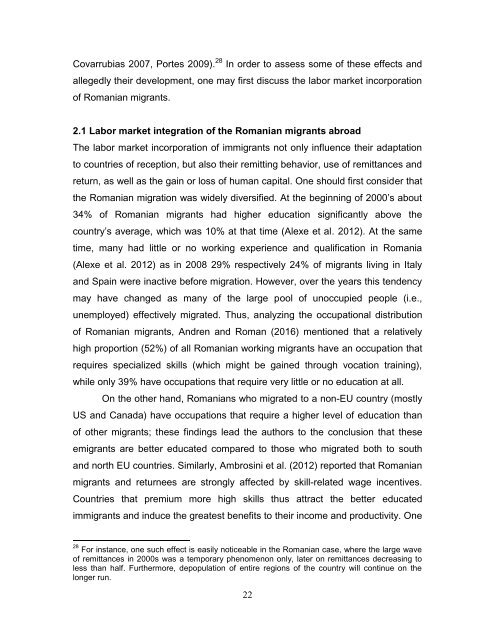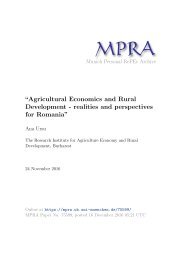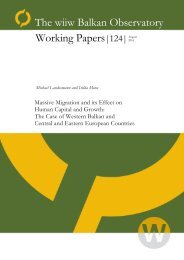You also want an ePaper? Increase the reach of your titles
YUMPU automatically turns print PDFs into web optimized ePapers that Google loves.
Covarrubias 2007, Portes 2009). 28 In order to assess some of these effects and<br />
allegedly their development, one may first discuss the labor market incorporation<br />
of Romanian migrants.<br />
2.1 Labor market integration of the Romanian migrants abroad<br />
The labor market incorporation of immigrants not only influence their adaptation<br />
to countries of reception, but also their remitting behavior, use of remittances and<br />
return, as well as the gain or loss of human capital. One should first consider that<br />
the Romanian migration was widely diversified. At the beginning of 2000’s about<br />
34% of Romanian migrants had higher education significantly above the<br />
country’s average, which was 10% at that time (Alexe et al. 2012). At the same<br />
time, many had little or no working experience and qualification in Romania<br />
(Alexe et al. 2012) as in 2008 29% respectively 24% of migrants living in Italy<br />
and Spain were inactive before migration. However, over the years this tendency<br />
may have changed as many of the large pool of unoccupied people (i.e.,<br />
unemployed) effectively migrated. Thus, analyzing the occupational distribution<br />
of Romanian migrants, Andren and Roman (2016) mentioned that a relatively<br />
high proportion (52%) of all Romanian working migrants have an occupation that<br />
requires specialized skills (which might be gained through vocation training),<br />
while only 39% have occupations that require very little or no education at all.<br />
On the other hand, Romanians who migrated to a non-EU country (mostly<br />
US and Canada) have occupations that require a higher level of education than<br />
of other migrants; these findings lead the authors to the conclusion that these<br />
emigrants are better educated compared to those who migrated both to south<br />
and north EU countries. Similarly, Ambrosini et al. (2012) reported that Romanian<br />
migrants and returnees are strongly affected by skill-related wage incentives.<br />
Countries that premium more high skills thus attract the better educated<br />
immigrants and induce the greatest benefits to their income and productivity. One<br />
28 For instance, one such effect is easily noticeable in the Romanian case, where the large wave<br />
of remittances in 2000s was a temporary phenomenon only, later on remittances decreasing to<br />
less than half. Furthermore, depopulation of entire regions of the country will continue on the<br />
longer run.<br />
22




